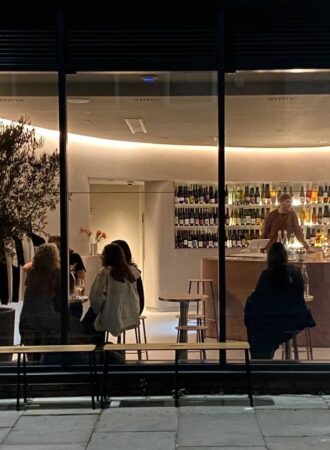Walk: Holme Valley
Difficulty: Moderate
Time: 3h 43m
Distance: 11.20km
Elevation: 397m
Finest has spent the past month waving goodbye to our beloved Manchester and heading off into comparative wilderness, exploring some of the best hiking routes accessible within 90-minutes of our city. All with our fantastic guide Hanna showing us the way. Still not done, this time we’re plotting a course back to God’s Own Country, also known as Yorkshire, and bringing a tour de force of the North West culinary scene along for the ride. Or walk.
Anna Søgaard is this week’s guest. Founder of Suppher, “an inclusive supper club powered by women with a focus on sustainably-sourced food and low-intervention wines,” she’s also Sous Chef at critically lauded Ancoats dining spot Erst, which Guardian food writer Jay Rayner labelled as one of his favourite meals last year. Given his rather critical thoughts on other Manchester restaurants, and fellow diners in the city, that’s certainly no mean feat.

Hanna Outdoors and Anna Søgaard
Digressions done, for our fourth adventure we are in Holme Valley, which, among other things, is home (ahem) to the picturesque village where classic UK TV comedy ‘Last of the Summer Wine’ was filmed. If you’re too young and missed that show, no worries. This instalment of Weekend Walks will take you up to an actual vineyard, where it’s possible to sample some wonderful English wines at your leisure. First, though, we start off at Digley Wood car park, around 22 miles from Finest’s HQ in the Northern Quarter. Just like our last episode, public transport options are slim and inconvenient, so you need a vehicle to get here.
Once parked up, take the footpath heading north east, along the side of the woodland itself and the expansive Digley Reservoir. You’ll cross a small beck after a couple of minutes, and find stunning countryside on display in every direction. Next, we approach Lumbank Wood, with the track veering to a more northerly direction, taking you through thick trees. Those unsure should keep an eye out for the rope swing — a good marker you’re heading in the right direction. And a lot of fun to play with if the mood strikes.

Lumbank Wood




Lumbank Wood
Unsurprisingly, given the propensity to rain in these ends, this part of the country has long-been relied on for fresh water supplies to northern towns and cities, and our next waypoint makes that clear.
Sticking on the same path, watch as the ground beneath your feet forms a long bridge between two huge reservoirs — Digley and Bilberry — making for a dramatic stroll that feels, as Søgaard quips, “very remote”. This place has a dark history, too. In 1852 the embankment of Bilberry collapsed, killing 81 people in the area and leading to a major rethink on how structural integrity is judged. Strikingly, the event still ranks among the deadliest incidents of flooding ever recorded.

Bilberry Reservoir / Digley Reservoir Bridge




Once safely on the other side, you’ll come to a fork in the path. Keep heading north (ish), passing Hoowood Lane, before things start to head east. This is the next highlight of the journey, as the track leads us into another area of beautiful woodland. Keep following this, and eventually you’ll glimpse an opening in the trees, bringing us out onto a sandy spot at the side of Digley Reservoir. It might sound ridiculous, but on a bright, sunny day this feels like discovering a hidden beach after navigating the unknown of the undergrowth. It’s also an ideal spot to grab something to eat, although whether anyone in your party has thought to bring fresh oysters, like Søgaard, is another question entirely.

Digley Reservoir






After a good feed, we now need to double back on ourselves, and continue onto the Kirklees Way, heading west. Borrowing its name from the West Yorkshire borough we’re in, this route is actually a 72-mile odyssey, which takes around six days to complete. Fear not, though, for Weekend Walks we’re not here for a long time, just a good time, so we’re only going to see a very small section before taking a path heading into a field past Goodbent Lodge. This traditional farmhouse is built from iconic black Yorkshire stone and hard to miss, as it stands alone among the grazing fields. Naturally, the panoramic views are jaw-dropping.

Kirklees Way




Next, it’s onto the barren beauty of the moors, and within minutes of setting eyes on the peat-laden landscape you know why this scenery has inspired so many artists and poets over the years. Follow the path, and you’ll start dropping towards a small stream, and the curiously titled Blackpool Bridge. Made from wood, it feels a million miles (at least) from the North West coastal resort, and we’re not sure where the name comes from. We do know a proud stone crossing once stood here, but lack of funding for maintenance, and the inaccessibility of the location, meant its replacement had to be made from minimal materials.

Blackpool Bridge





Once on the other side, stick to the snaking path through Stopes Moor, back to Holme, close to where all this began, taking Issues Road and then Meal Hill Road to get there. We’re not stopping long, though. Instead, take a left onto Woodhead Road in the centre of ‘town’, then immediately right down a track just after the fork. Follow this through Underhill, Lower Fold Farm, and into Netherley Wood. Another secluded area, the path brings you onto a bridge over two more reservoirs: Ramsden and Brownhill.

Stopes Moor



Get to the other side and head north up the eastern bank of Brownhill, into Holmbridge: a picturesque hamlet will make you wonder why you don’t live here. Follow Hollin Brigg Lane south until it meets Woodhouse Lane, and the latter leads directly to our grand finale. Holmfirth Vineyard isn’t the most northerly in the country, but it is the highest wine producing spot in the UK, sitting at 840 feet above sea level. With the area regularly freezing over, only hybrid vines can grow, capable of surviving temperatures as low as -24°C. Our recommendation is a glass of Solaris, a white tipple billed as Britain’s answer to Sauvignon Blanc, and an ideal way to round off an excellent experience.

Holmfirth Vineyard








